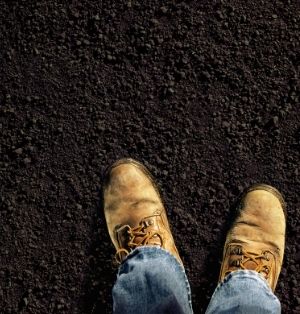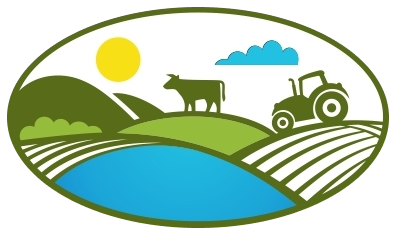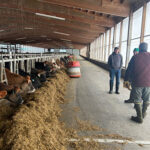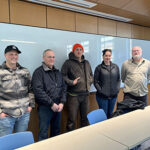
The following letter, written by CVFC Board Vice President Marie Audet of Blue Spruce Farm in Bridport, was published in the December 30, 2020 edition of the Manchester Journal, on VTDigger on January 4, 2021, and in the January 7, 2021 edition of the Addison Independent.
COVID-19 has affected every aspect of our lives. We are all suffering on so many levels and the uncertainty of what lies ahead takes a toll. While news of the vaccine brings us hope, it will be months or more before we are safe.
Hopefully the summer will bring back a sense of normalcy in our daily lives and renewed energy for another fight: the fight against climate change.
At Blue Spruce Farm, we are adapting to the immediate impacts of COVID-19 while remaining steadfast in creating a future with cleaner water, healthier soil, and cleaner air. It is time for us collectively to reverse climate change with the same urgency we have approached defeating COVID-19. We are doing our part through regenerative agricultural practices to save and improve our soils and sequester carbon, drawing down carbon dioxide from the air.
Soil is what gives us life. Of all the food that we eat, 95 percent is from the soil. Healthy soil acts like a sponge, soaking up and holding on to water, and sequestering carbon. Organic matter has a great influence on soil properties and structure; it is measurable and serves as an indicator in improving soil health. Every one percent increase in organic matter can result in up to 20,000 gallons of available water stored per acre. That means with the predicted increase in extreme flooding, our soil will hold more water and prevent it from flooding and washing away.
In years with droughts, like 2020, this same organic matter preserves precious soil moisture, making it available to our crops. In contrast, if our cropland were developed into urban use, it would have four times as much potential for phosphorus runoff, according to the Lake Champlain Basin Program.
Dairy farming is evolving with the science, driving innovation and implementation of new, gentler equipment and regenerative practices. The greatest investments in the last decade have been in adaptation of these evolving practices.
We are sowing our crops with minimal tillage while the plows have been gathering dust for more than 10 years. Our new planters now push seeds down into the soil without disturbing the soil structure, organic matter, and soil biology.
Our cow manure goes through an anaerobic digester where the methane is captured to generate renewable electricity. The plant fibers are separated from the manure to be used as fluffy bedding for the animals; the liquid goes into a Dissolved Flotation System that separates out 70-78 percent of the phosphorus. The crops that were grown to feed the cows go on to make renewable electricity and then get recycled back to the soil, closing the loop.
Vermont’s farmers are leading the nation in adopting conservation practices. Between 2012 and 2017, we increased our acres of no-till land by 173 percent, the biggest increase in the US according to the 2017 U.S. Census of Agriculture. We ranked in the top seven states in the country for our 101 percent increase in adoption of cover crops. That means today more than 30 percent of Vermont’s cornfields have cover crops planted in the fall. The U.S. average is only 5 percent.
Dairy farmers are quietly and without recognition drawing carbon down from our atmosphere through cover crops and rebuilding healthy soil. Yet, there is more to this story than sequestering carbon and protecting our soil in the face of climate change. Dairy farmers are on track to continue to provide affordable, safe, nutritious food, packed with flavor, vital nutrients, and up to 19 percent of the natural protein in our diets.
The dairy industry has collectively pledged to become carbon neutral or better by 2050. That work is well on its way. Our farm is a host site for a rigorous study that recently started in Addison County. Dr. Joshua Faulkner, who is a Research Assistant Professor and Farming and Climate Change Program Coordinator for the UVM Extension Center for Sustainable Agriculture, described this research as, “one of the first in the country that will study direct links between soil health, water quality, and green house gas emissions.”
On our farm, we are raising our fourth generation — a total of 21 family members and growing — which provides plenty of motivation to care for our land, care for our animals, and preserve our farm for future generations. Participating in a study of this magnitude will test the new practices and technology right here where we all live to help us get to the future we want. We want to be your partners for a healthier planet for all of our children.
We are at a critical point. We’re losing more and more Vermont dairy farms every year. USDA data shows that since 1987, Vermont has lost 32% of its cropland, or 225,000 acres. Food Solutions New England’s vision states we must build capacity to produce at least 50 percent of our food by 2060. As a region, New England currently produces only half of its own dairy, according to USDA data. We cannot afford to stay on this downward trajectory. If we do, we lose our potential to have local food and to manage our land to mitigate the negative impacts of climate change.
The solution to the challenges of climate change, like flooding and extreme temperatures from carbon emissions, has been right under our feet all along. It lies in our collective decision to support our farmers in their revolution to build healthy soil. I hope you will support us as we work hard to protect our land, air, and water resources while producing local, nutritious food for our region.




